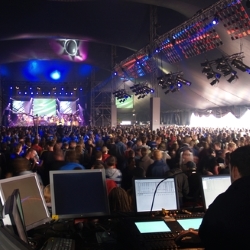
Countless Reflections
Acoustic reverberation is the result of countless reflections of the original sound each arriving, at any given listening position, at a different time; thereby smearing the transient attack of the sound we are hearing.
In addition, the higher frequency components of that sound have less acoustic energy and are more easily absorbed or dissipated than lower frequencies. The combination of these two factors conspires to rob a musical performance of intelligibility and a sense of rhythm. As a result we often hear the term ‘boomy’ or ‘muddy’ used to describe this type of acoustic environment.
It is apparent then, that if we are to mitigate the effects of the reverberant field by the use of delayed loudspeaker arrays, the frequency content of the delayed sound is of paramount importance. Of course there are other factors to consider in the installation of delay zones. We’ll start with the positioning of each delay cluster.
A Pleasing Ambience
The idea is to provide each listener with a direct field of sound in which reverberation becomes a pleasing ambience; an enhancement of, rather than of detriment to, the music.
Theoretical the ideal position for a delay cluster is directly between a listener and his source. As this would necessitate on delay cluster for each seat in the auditorium let’s say ‘au revoir’ to theory.
Instead look at the venue in terms of the direct fields provided by your equipment. Decide the area you can cover with the main loudspeaker arrays without deafening those nearby, and visualize the direct fields that will be provided by the delay speakers you are using and position them accordingly.
Bearing in mind their characteristics of efficiency and dispersion you can position the delay clusters so that each direct field will intersect with that provided by the adjacent delay cluster. In this way it is possible to determine the number of zones of coverage that will be required and also the number of delay clusters needed within each zone.
If this methodology sounds arbitrary and, indeed, vague, it is not. Rather, the whole process of installing temporary sound systems on a day to day basis is empirical. I cannot stress strongly enough the importance of experience when it comes to the selection of audio crews and engineers. However it is not within the scope of this article to open that particular can of worms.
Father Time
Moving now to that most obvious of elements in setting up of a delayed zone system, we’ll look at the delay time itself. How does one determine that particular increment of the old father’s domain? But don’t get excited by the prospect of my finally introducing a scientific fact into this diatribe, you’ll be disappointed.
Calculations involving division of 186,000 by X hold little relevance to my beleaguered, but practical mind. Having decided upon placement and then installed my delay cluster, I might pace out the intervening distance to the main loudspeaker array or I might imagine how many tour buses would fit in between.
If it were 1 1/2 tour buses, I would set my digital delay line (DDL) to approximately 70 milliseconds(ms). Put aside your screams of “heresy” and “schism” or “who is this lunatic?!” for I do not leave the process there. I would be remiss and wrong if I did. So would you, even if you arrive at your setting(s) with the aid of a tape measure and calculator and the invocation of the teachings of Pythagoras. Unless of course you’d installed one delay cluster for every seat in the room!
The next step is to emit a fast transient sound or pulse from your main and delayed loudspeaker arrays. What that pulse is doesn’t matter as long as it has a fast attack time; I use a snare drum beat trapped by the A/B repeat function of my CD player.
Where to Stand
Positioning myself so that one of the delay clusters is directly between me and the stage I fine tune the length of my bus and a half until the emitted sound from the main speaker is indistinguishable from that of the delayed speaker.
Moving halfway between two delay clusters will reveal different arrival times of the pulse from the two sources and using, Lord help us, my ears, I adjust delay time until the perceived deviation is the same either directly in front of the delay cluster or mid-way between it and its neighbor.
It may be more appropriate, depending upon circumstances, to set the initially ‘correct’ delay time from a point in the delay zone that is both mid-way between two delay clusters and mid-way between the main left and right loudspeaker arrays.
Either way, the important thing is that the inevitable variations in arrival time have been averaged and are now less noticeable throughout the delayed zone of coverage.
(1) This term refers to the use of loudspeaker arrays (delay clusters) arranged in zones progressively further away from the stage, with each zone delayed in time by an amount commensurate with its distance from the stage or main sound system.
John Godenzi is a long-time front of house engineer. See Part 2 of this article here
